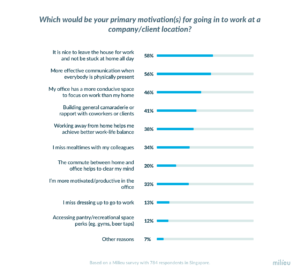
Hybrid Work– The What, the Why and the How
This is a collaboration HR article between Reeracoen and Huubap!
Written by Clare Chong (Reeracoen) and Aason (Huubap).
If you would like to find read more interesting HR-related articles like this as well, please visit: https://www.reeracoen.sg/en/articles
Before the advent of the Covid-19 pandemic, the definition of hybrid work takes on many shapes. However, the most coined Hybrid work arrangement (in full) is now almost exclusively referring to a work schedule that allows the employees to work remotely on a frequent basis.
This arrangement was necessitated during the pandemic but was also a huge push for companies to experiment and adapt quickly to the situation. Many operations still have to continue and businesses all over the globe did a baptism by fire in order to survive.
Now that the situation of the pandemic has reached a stabilisation phase, can businesses truly revert to its original state? Are there only cons of hybrid work arrangement or are there enough pros as well for companies to consider continuation of staggered work schedules?

We first see what the employees feel about hybrid work and their preferred work arrangement in a recent survey done by Milieu Insight:
———————————————-
Preference for remote work is not going anywhere
Having the flexibility to work remotely appears to be the prevailing choice among employees in Singapore with most (78%) leaning towards a hybrid schedule. Employees are far less enthusiastic about going all in on one environment: Only 12% would prefer working from the office all the time, and 10% want to work remotely full-time.
Besides the majority (90%) indicating they can save time and money on commuting to and from work, those on hybrid work arrangements also highlighted improved work-life balance and a less stressful working environment as perks of working from home (WFH). With more time and fewer office stressors, on average, those currently on a hybrid work arrangement seem to experience a boost in their quality of life.
Making hybrid work a success
With the hybrid model designed for flexibility of working remotely, while still offering structure, stability, and social advantages, we wanted to understand employees’ primary motivation(s) for going into work.

We can see that employees have various reasons for a hybrid work arrangement and at a significant 78% of those surveyed. We are expecting the dynamics of attracting and recruiting talents to change and adapt to this. Companies that are aligned to the preferences of the masses would likely have first-say in picking from a larger pool of candidates. Reeracoen Singapore, with a wealth of professional recruitment experience and a strong team of consultants, will be able to match suitable job seekers to business clients who are seeking to attract the best talents for their companies. With a fuss-free 5 step consultation process, the job applicant only need to (1) register an online account with Reeracoen Singapore; (2) go for a customised career counselling with one of our friendly consultants; (3) attend interviews with prospective companies; (4) and the consultant will negotiate for the best offer ; (5) finally, embark on the dream career!
Successful placements have been made across a wide range of hot industries from Information Technology to Banking and Finance amongst many others, with attractive roles such as Programme developer to digital marketer.
Any forward-looking CEO and business owner should be taking their time out to consider how this shift could affect their industry and operations. Being a leader means always being ready for change and then effectively managing it when it happens. The hybrid, work-from-anywhere workforce is here for the foreseeable future, and employees want employers to adapt and evolve quickly and intelligently. It may seem straightforward, but the CEO must also look for the tools that can provide the employees to work better remotely.
How would my employees conduct meeting? How would my employees communicate as a team? How to keep employees engaged? There must be a playbook and leaders should work with the HR team to formulate key guidelines so that managers and their teams are clear on what’s required. My company at Huubap have been doing hybrid work arrangement even before the pandemic. I will be sharing a little about what worked for us.

Some cloud services and collaboration software that could make remote work even more efficient– The Google Suite and Slack combination is something that my company is using.
Google Docs can allow multiple employees to work on the same document at the same time and see each other’s progress and changes in real-time. Additionally, any updates made are immediately reflected on everyone’s copy. This could mean a lot for things like updating SOPs or official documents. This greatly reduces the number of e-mails required and the managers can monitor without disrupting and asking for updates from the staff who is working on the files thus improving work efficiency!
For Slack, our teams have created several channels to better segregate and organise the communications. It is a far superior communication for intra-company than using E-mails. Furthermore, we made use of custom emoticons and included Giphy functions to make things more interactive and fun within the team. You may also explore apps and add-ons to encourage staffs to be more proactive and help each other. One such app that we use at Huubap is called Karma. There is a leaderboard for members who receive the highest “karma” by receiving thank you or certain emoticons. This is just one of the many ways that companies can foster an interactive online work environment.

But with a hybrid work arrangement, the managers would also need to be able to better manage and monitor the movement of the employees. This is where KING OF TIME, a product of HUUBAP comes in handy. KING OF TIME helps to manage time attendance, leave, and also schedule management as well.
The highlight of KING OF TIME is that it is highly customizable, and companies will be able to set-up according to their HR policies.
Some examples:
- We can set different OT rates for different time periods. You can have 1.5x from between 6-8pm and 2.0x rate from 8-10pm.
- It can be adapted for flexible work schedule so that employees can start work at any time if they fulfil the required working hours for the day.
- If they have a fixed routine like Mon-Wed WFH and Thurs-Friday to work from office, KING OF TIME can be used to reflect that as well. Staff can also apply to make schedule changes that is subjected to Manager’s approval. In this way, the manager will always be notified.
With the daily data available, managers can easily have an overview on the workforce condition with a single portal. That is, who called in sick, who is working from where and started work at what time. Without a tool like KING OF TIME, managing the employees would be more hindering (if they had to message/e-mail to ask). Reducing the amount of communications necessary for operations would mean less interruptions to actual business projects and bring value to the customers and the underlying.
All in all, we can see that companies have advantages to quickly adapt new policies but must not forget to equip the workforce with the necessary tools. The right tool for the right work (in the right environment too) would improve efficiency. We hope that you have gained some useful takeaways and it helped get you excited to look out for these ‘new tools’ to implement hybrid work in your workplace!